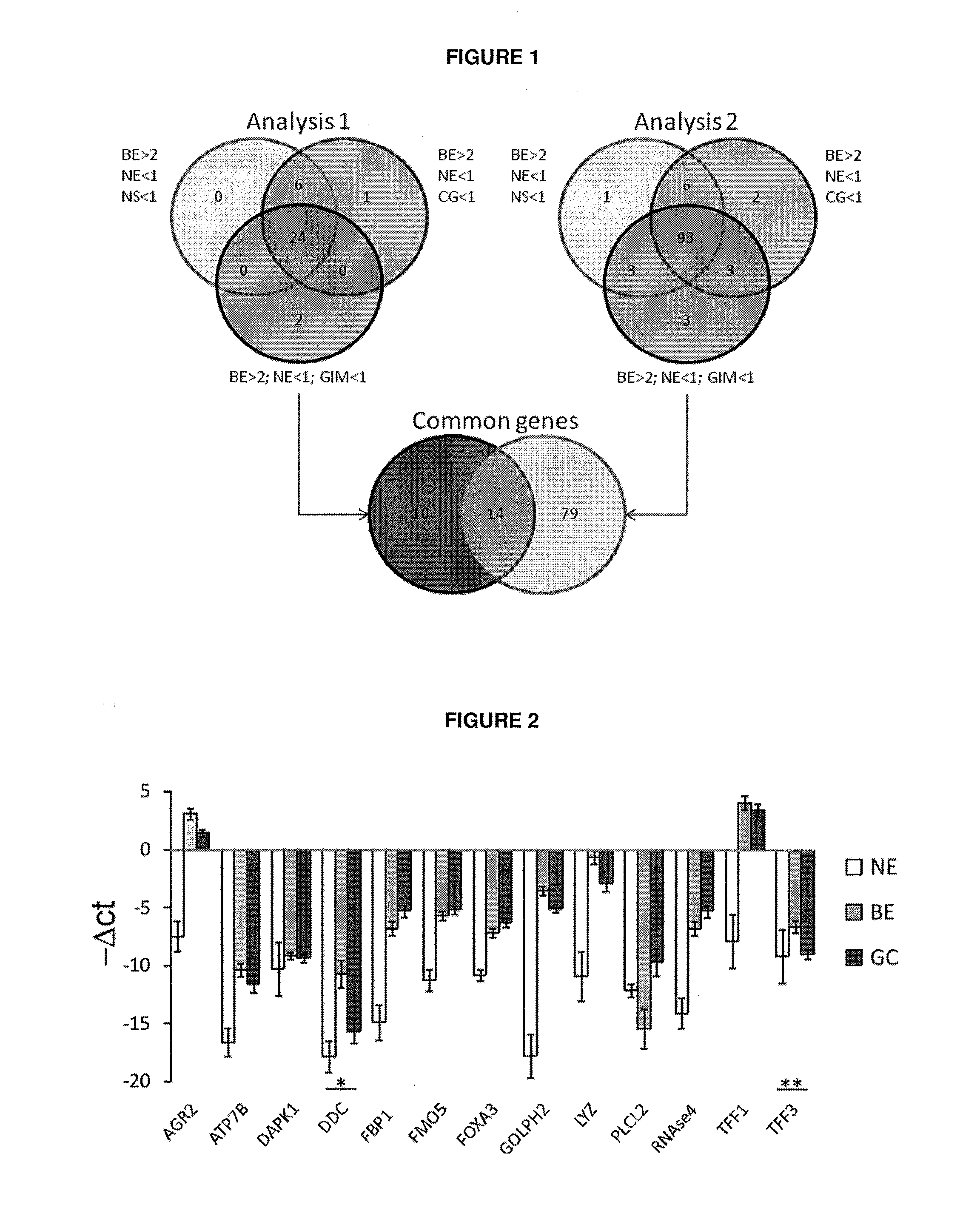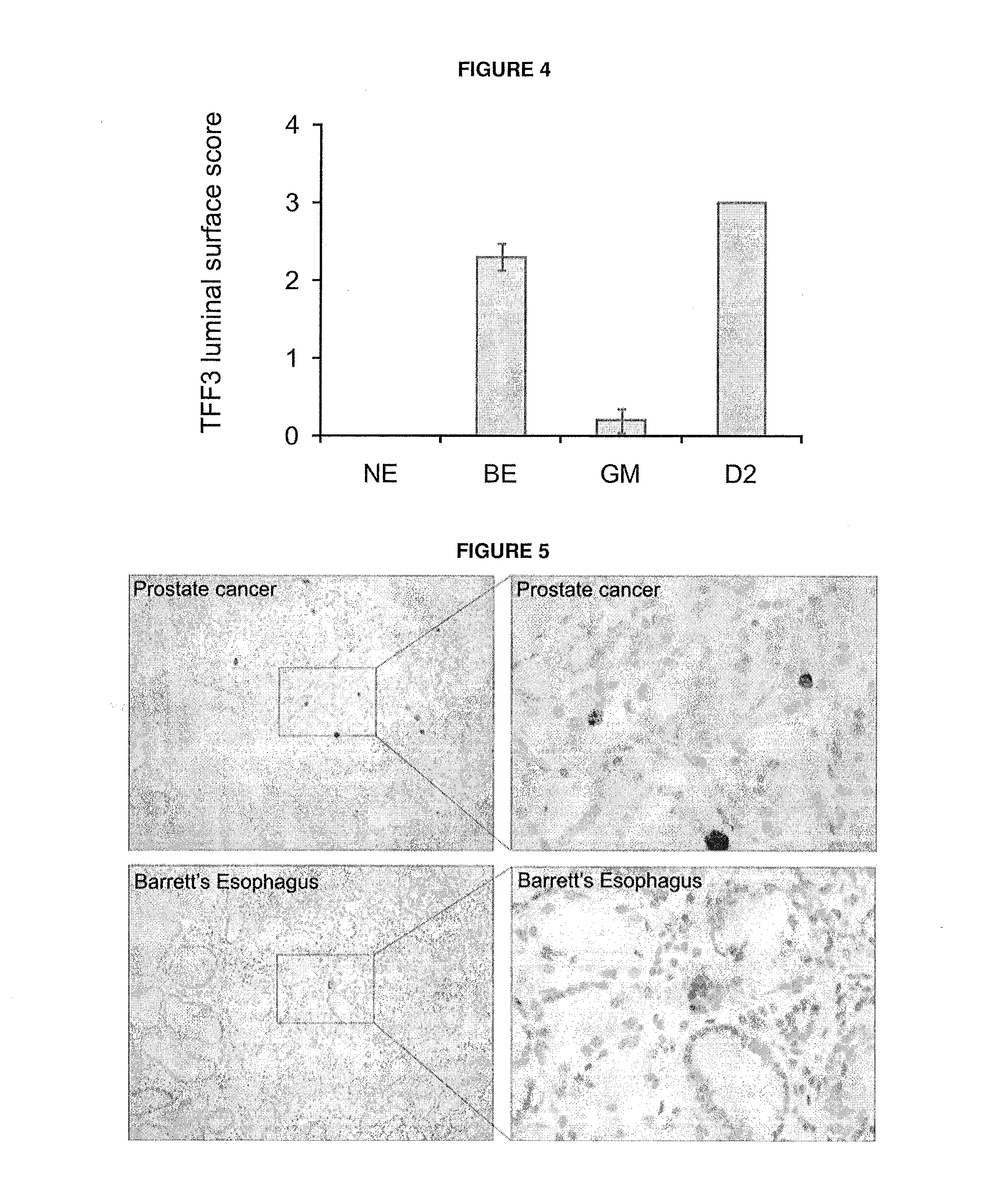Biomarker for barrett's oesophagus
a biomarker and oesophagus technology, applied in the field of diagnostic methods, can solve the problems of large number of patients who remain undiagnosed in the population, major feasibility and cost implications, and morphology alone is often not sufficient to diagnose patients, and achieves superior specificity and sensitivity. , the effect of high specificity
- Summary
- Abstract
- Description
- Claims
- Application Information
AI Technical Summary
Benefits of technology
Problems solved by technology
Method used
Image
Examples
example 1
Identification of Putative Targets
[0105]We used a strategy involving three microarray datasets to screen for candidate genes that were specifically expressed in BE. Twenty four genes from analysis 1 (Hao / Boussioutas) were found to be statistically overexpressed in BE (1092 ratio >2) compared to NE (log2 ratio22 ratio comparisons 93 genes were identified from analysis 2 (Greenawalt / Boussioutas), (FIG. 1).
[0106]Microarray Analysis
[0107]The invention is based in part on a substantial leap forward in the translation of high throughput laboratory results into an assay that can be used in the clinic. The microarray experiments were not designed specifically to identify markers distinguishing between BE, NE and GM and to our knowledge no dataset including normal oesophagus, Barrett's oesophagus and normal gastric mucosa exists. Furthermore, the microarray platform by of Hao et al. [32] was different from the platform used by Boussioutas et al.[33] and Greenawalt et al.[34]. This explains t...
example 2
Validation of Targets
[0112]Human Specimens
[0113]Patients undergoing upper GI endoscopy were recruited to this biomarker study from Addenbrooke's Hospital following approval by the Local Research Ethics Committee. All patients with BE, had an endoscopically visible columnar lined segment of more than 3 cm and a histopathological diagnosis of specialized intestinal metaplasia. For NE samples were taken 2 cm above the z-line in patients with BE and 2 cm above the gastro-oesophageal junction (GOJ) in patients without BE who were undergoing symptomatic evaluation as part of the routine surveillance service.
[0114]The microarray targets were validated using real-time PCR (RT-PCR) in 10 samples from each of BE, NE (5 from Barrett's patients and 5 from non-Barrett's patients with a normal oesophagus) and 10 GM samples (collected from the cardia of Barrett's patients, table 2). The cardia was defined as 1 cm below the upper border of the gastric folds at the lower oesophagus in non-Barrett's ...
example 3
TFF3 Expression in Samples Collected with the Capsule Sponge
[0123]Since TFF3 fulfilled the necessary criteria, in that expression was restricted to the luminal surface of BE with no expression seen in gastric or normal squamous oesophageal tissues this was taken forward to the prospective capsule sponge screening study. TFF3 expression in specimens from 46 histologically confirmed BE patients were compared to 99 patients without BE.
[0124]Capsule Sponge Specimens
[0125]Following approval by the Cambridge Local Research Ethics Committee, 29 patients with known long-segment BE and 99 control patients (table 2), whose diagnosis was verified by endoscopy, were recruited. Only patients with a segment ≧3 cm were recruited to avoid erroneous diagnoses of hiatus hernia. Control patients were selected on the basis that they had reflux symptoms sufficient to require a prescription of acid-suppressant for a minimum of 3 months over the last 5 years but without diagnosis of BE. The patients were ...
PUM
 Login to View More
Login to View More Abstract
Description
Claims
Application Information
 Login to View More
Login to View More - R&D
- Intellectual Property
- Life Sciences
- Materials
- Tech Scout
- Unparalleled Data Quality
- Higher Quality Content
- 60% Fewer Hallucinations
Browse by: Latest US Patents, China's latest patents, Technical Efficacy Thesaurus, Application Domain, Technology Topic, Popular Technical Reports.
© 2025 PatSnap. All rights reserved.Legal|Privacy policy|Modern Slavery Act Transparency Statement|Sitemap|About US| Contact US: help@patsnap.com



